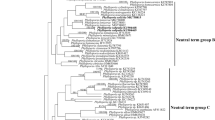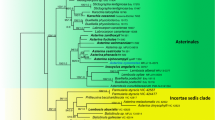Abstract
Previous phylogenetic analyses revealed that species within the genera Nimbya and Embellisia reside within a large monophyletic clade that also includes the genera Alternaria, Ulocladium, Undifilum, Sinomyces, and Crivellia with Stemphylium as the sister taxon. This study expands upon previous work by including many contemporary species of each genus and utilizes molecular and morphological characters to further examine relationships. Maximum parsimony and Bayesian analysis reveals that Nimbya is not a monophyletic genus but is split into two phylogenetically distant clades, which have different and distinct conidial morphologies. One of these clades resides completely within Alternaria. Phylogenetic analyses also reveals that Embellisia does not form a monophyletic genus but is split into four monophyletic lineages. Moreover, several species of Embellisia cluster individually with clades that are predominantly Alternaria, Ulocladium, or Stemphylium, yet these Embellisia spp. possess morphological characters that are diagnostically Embellisia. Thus, these data reveal that both Nimbya and Embellisia are polyphyletic as currently defined and taxonomic restructuring is necessary in order to resolve conflict between historical morphological and contemporary molecular-based phylogenies.





Similar content being viewed by others
References
Berbee ML, Pirseyedi M, Hubbard S (1999) Cochliobolus phylogenetics and the origin of known, highly virulent pathogens, inferred from ITS and glyceraldehyde-3-phosphate dehydrogenase gene sequences. Mycologia 91:964–977
Chen WQ, Lin XF, Zhang TY (1997) A new species of Nimbya. Mycosystema 2:106–108
Crivelli PG (1983) U¨ ber die heterogene Ascomycetengattung Pleospora Rabh.: Vorshlag fu¨r eine Aufteilung.— Diss. ETH. Nr. 7318. Zu¨rich: ADAG Administration & Druck AG. 213 p
David JC, Coles K, Fisher J, Moss ST (2000) A new species of Embellisia from soil with high levels of heavy metals. Mycoscience 41:533–537
de Hoog GS, Muller PJ (1973) A new species of Embellisia associated with skin disease of hyacinths. Neth J Plant Path 79:85–93
de Hoog GS, Seigle-Murandi F, Steinman R, Eriksson KE (1985) A new species of Embellisia from the North Sea. J Microbio 51:409–413
Eriksson OE, Hawksworth DL (1991) Notes on ascomycete systematics. Systema Ascomycetum 12:1–38
Fuckel L (1863) Fungi rhenani exsiccate, Fasc. I, No. 1–100.
Goldman N, Anderson JP, Rodrigo AG (2000) Likelihood-based tests of topologies in phylogenetics. Syst Biol 49(4):652–670
Hasegawa M, Kishino H (1989) Confidence limits on the maximum-likelihood estimate of the hominoid tree from mitochondrial-DNA sequences. Evolution 43:672–677
Hoes JA, Bruehl GW, Shaw CG (1965) A new Pseudostemphylium. Mycologia 57:904–912
Holcomb GE, Antonopoulos AA (1976) Alternaria alternantherae: A new species found on alligatorweed. Mycologia 68:1125–1129
Hong SG, Cramer RA, Lawrence CB, Pryor BM (2005) Alt a1 allergen homologs from Alternaria and related taxa: analysis of phylogenetic content and secondary structure. Fungal Genet Biol 42:119–129
Huelsenbeck JP, Ronquist F (2001) MRBAYES: Bayesian inference of phylogenetic trees. Bioinformatics 17:754–755
Johnson DA, Simmons EG, Miller JS, Stewart EL (2002) Taxonomy and pathology of Macrospora/Nimbya on some North American bulrushes (Scirpus spp.). Mycotaxon 84:413–428
Maddison DR, Maddison WP (2003) MacClade 4.06: analysis of phylogeny and character evolution. Sinauer Associates, Sunderland, MA
Muntanola-Cvetkovic M, Ristanovic B (1976) A new species of Embellisia isolated from seawater. Mycologia 68:47–51
Posada D, Crandall KA (1998) Modeltest: testing the model of DNA substitution. Bioinformatics 14(9):817–818
Pryor BM, Bigelow DM (2003) Molecular characterization of Embellisia and Nimbya species and their relationship to Alternaria, Ulocladium and Stemphylium. Mycologia 95:1141–1154
Pryor BM, Gilbertson RL (2000) Molecular phylogenetic relationships amongst Alternaria species and related fungi based on analysis of nuclear ITS and mt SSU rDNA sequences. Mycol Res 104:1312–1321
Pryor BM, Michailides TJ (2002) Morphological, pathogenic, and molecular characterization of Alternaria isolates associated with Alternaria late blight of pistachio. Phytopathology 92:406–416
Pryor BM, Creamer R, Shoemaker RA, McLain-Romero J, Hambleton S (2009) Undifilum, a new genus of endophytic Embellisia oxytropis and Helminthosporium bornmuelleri on legumes. Bot 87:178–194
Rokas A, Williams BL, King N, Carroll BS (2003) Genome-scale approaches to resolving incongruency in molecular phylogenies. Nature 425:798–804
Runa F, Park MS, Pryor BM (2009) Ulocladium systematics revisited: phylogeny and taxonomic status. Mycol Prog 8:35–47
Saccardo PA (1886) Sylloge Fungorum. Vol. IV. Padova: Publ by the author. p 807
Simmons EG (1967) Typification of Alternaria, Stemphylium, and Ulocladium. Mycologia 59:67–92
Simmons EG (1971) Helminthosporium allii as type of a new genus. Mycologia 63:380–386
Simmons EG (1983) An aggregation of Embellisia species. Mycotaxon 17:216–241
Simmons EG (1986) Alternaria themes and variations (22–26). Mycotaxon 25:287–308
Simmons EG (1989) Macrospora Fuckel (Pleosporales) and related anamorphs. Sydowia 41:314–329
Simmons EG (1990) Embellisia and related teleomorphs. Mycotaxon 38:251–265
Simmons EG (1992) Alternaria taxonomy: current status, viewpoint, challenge. In: Chelkowski J, Visconti A (eds) Alternaria biology, plant diseases and metabolites. Elsevier Science Publishers, Amsterdam, pp 1–35
Simmons EG (1995) Alternaria themes and variations (112–144). Mycotaxon 55:55–163
Simmons EG (1997) Alternaria themes and variations (151–223). Mycotaxon 65:1–91
Simmons EG (2000) Alternaria themes and variations (244–286): species on Solanaceae. Mycotaxon 75:1–115
Simmons EG (2004) Novel dematiaceous hyphomycetes. Stud Mycol 50:109–118
Simmons EG (2007) Alternaria an identification manual. CBS Fungal Biodiversity Centre, Utrecht, The Netherlands, pp 10–12
Sivanesan A (1984) The Bitunicate Ascomycetes. J. Kramer, Vaduz, p 701
Swofford DL (2002) PAUP*. Phylogenetic analysis using parsimony (*and other methods). Version 4. Sinauer Associates, Sunderland, Massachusetts
Tóth B, Csõsz M, Szabó-Hevér A, Simmons EG, Samson RA, Varga J (2011) Alternaria hungarica sp. Nov., a minor foliar pathogen of wheat in Hungary. Mycologia 103:94–100
Wang Y, Pei Y, O’Neill NR, Zhang X (2010) Ulocladium cantlous sp. nov. isolated from northwestern China: its morphology and molecular phylogenetic position. Mycologia 102:374–383
Wang Y, Geng Y, Ma J, Wang Q, Zhang X (2011) Sinomyces: a new genus of anamorphic Pleosporacea. Fungal Biology 115:188–195
White TJ, Bruns T, Lee S, Taylor J (1990) Amplification and direct sequencing of fungal ribosomal RNA genes for phylogenetics. In: Innis MA, Gelfand DH, Sninsky JJ, White TJ (eds) PCR protocols: a guide to methods and applications. London: Academic Press, London, pp 315–322
Zhang Y, Schoch CL, Fournier J, Crous PW, de Gruyter J, Woudenberg JHC, Hirayama K, Tanaka K, Pointing SB, Spatafora JW, Hyde KD (2009) Multi-locus phylogeny of Pleosporales: a taxonomic, ecological and evolutionary re-evaluation. Stud Mycol 64:85–102
Zhao GZ, Zhang TY (2005) Notes on dictyosporous hyphomycetes from China VII. The genus Nimbya Fungal Diversity 19:201–215
van Zinderen Bakker EM (1940) Cercospora scirpicola (Sacc.) nov. comb. Revue de Mycol 5:64–69
Acknowledgments
This work was supported in part by the University of Arizona College of Agriculture and Life Sciences, Tucson, and the National Science Foundation (DEB No. 0918758).
Author information
Authors and Affiliations
Corresponding author
Rights and permissions
About this article
Cite this article
Lawrence, D.P., Park, M.S. & Pryor, B.M. Nimbya and Embellisia revisited, with nov. comb for Alternaria celosiae and A. perpunctulata . Mycol Progress 11, 799–815 (2012). https://doi.org/10.1007/s11557-011-0793-7
Received:
Revised:
Accepted:
Published:
Issue Date:
DOI: https://doi.org/10.1007/s11557-011-0793-7




